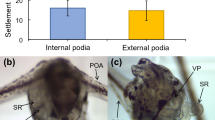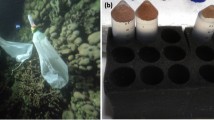Abstract
Sessile marine invertebrate larvae can recognize suitable settlement substrata by using various environmental cues, including organic/microbial biofilms. In laboratory choice assays, the effect of biofilms of varying ages on the settlement behaviour of two fouling organisms was assessed. The species included the arborescent cheilostome bryozoan Bugula flabellata (Thompson) and the solitary ascidian Ciona intestinalis (L.), both of which are characteristic of temperate sublittoral hard substratum assemblages in northwest Europe. Experiments were carried out using polystyrene petri dish substrata preconditioned with multispecies biofilms from natural laboratory-aquarium seawater for 1, 3, 6 or 12 d. Unfilmed (new, initially sterile) dishes were used as control substrata. Whereas the coronate larvae of B. flabellata generally were inhibited by biofilming, irrespective of film age, the settlement of tadpole larvae of C. intestinalis was facilitated on biofilmed substrata, and numbers of settled larvae generally increased with biofilm age: the highest mean numbers were counted on 12 d-old biofilms. In C. intestinalis, settlement and metamorphosis are processes which can be temporally separate and are possibly induced by different environmental cues. This study therefore distinguished between C. intestinalis larvae which were attached to the biofilm surface by the anterior, and those larvae entrapped by the biofilm but not settled in the conventional meaning of the term. As reported in previous studies, we did observe that such entrapped larvae could subsequently attach and develop successfully into sessile juveniles. Both the numbers of “attached” and “trapped” tadpoles increased with biofilm age. Assuming that “settlement” is essentially a process involving the active behavioural response of larvae to environmental cues, it seems that the facilitated attachment of C. intestinalis onto biofilmed substrata is due to the combined effect of active habitat selection and passive deposition/“entrapment” of larvae onto the “sticky” substratum.
Similar content being viewed by others
Author information
Authors and Affiliations
Additional information
Received: 21 August 1996 / Accepted: 21 November 1996
Rights and permissions
About this article
Cite this article
Wieczorek, S., Todd, C. Inhibition and facilitation of bryozoan and ascidian settlement by natural multi-species biofilms: effects of film age and the roles of active and passive larval attachment. Marine Biology 128, 463–473 (1997). https://doi.org/10.1007/s002270050113
Issue Date:
DOI: https://doi.org/10.1007/s002270050113




